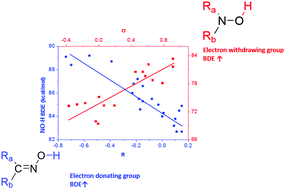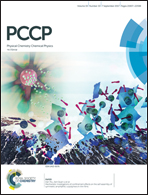Landscape of the structure–O–H bond dissociation energy relationship of oximes and hydroxylamines†
Abstract
The relationship between the homolytic O–H bond dissociation enthalpies (BDEs) and the structures of N-oxyl radical precursors (i.e. hydroxylamines and oximes) is important to predict their reactivity. Yet several crucial facts remain hidden to complete the picture such as the substituent electronic effects on the BDEs of oximes. In this work, the O–H BDEs of 120 hydroxylamines and 120 oximes have been calculated. It was found that the majority of the iminoxyl radicals are σ radicals, except for some π radicals. The resonance effect dominates the electronic effects on the BDEs of oximes, and electron-donating conjugation increases the BDE. However, both the resonance and the inductive effects are important in the BDEs of hydroxylamines; meanwhile, the BDEs increase with the increase of the electron-withdrawing ability of the substituents. Besides, the ΔBDEs of oximes and hydroxylamines with two substituents almost equal the algebraic sum of the ΔBDEs of single substituents. In addition, dipole–dipole repulsion is responsible for the difference in the BDEs of open chain and cyclic acyl hydroxylamines. Although the ring strain affects the N–O bonding property of nitroxide radicals, it has negligible effect on the BDEs of oximes. These new rules provide a complete and precise understanding of the structure–bond energy relationship of N-oxyl radical precursors.



 Please wait while we load your content...
Please wait while we load your content...